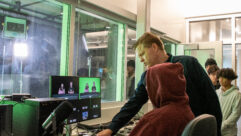AV, IT And Education
The relationship of pro AV with IT has been sometimes friendly and sometimes hostile. In the end, we’ll have to work it out.
The AV Industry is rich with technology, change, challenges and opportunities, so there’s been a lot to talk about in the five years that I have been writing this column. After more than 60 of them, there’s still more to say, but I’m moving on to let others say it for now. And what better month than “InfoComm June” to bid my farewell to this space? I leave you with a few thoughts on issues that continue to be an important part of our lives as we deal with the future of pro AV: IT providers in AV, networked AV, and education.
A Little AV with Your IT?
The relationship of pro AV with IT has been sometimes friendly and sometimes hostile. In the end, we’ll have to work it out. In the meantime, we just have to work on it. Many AV consultants and integrators have been putting a few toes in the IT waters, and some have jumped right in. And talk of “convergence” has created discomfort in some AV professionals who fear that pro AV will be consumed by IT. I think perhaps the more accurate statement is that AV may be outrun by IT in some cases.
Make no mistake about it: IT providers will be competing with us and perhaps get some of our projects, our personnel and our jobs. As both industries evolve, there likely will be less distinction between IT providers and AV providers. While AV providers are learning about IT, IT providers are learn something about AV, too. The prime example of this is in digital signage.
Many AV providers have shrewdly entered into digital signage, but so have a lot of traditional IT providers. A recent survey of 177 IT solution providers showed that they think digital signage is firmly in the “early adopter” phase of the Everett Rogers adoption curve, with a fair showing in the “early majority” phase. This means that IT providers are taking notice of an AV niche that they are fairly well-suited to tackle.
IT providers as a whole aren’t ready to plunge into a board room or university classroom building AV project, but they can probably do OK in digital content creation, networking and display. Once they get through that learning curve, they’ll be ripe to enter more traditional pro AV work and begin to compete with the rest of the AV industry. Other trends will give some IT providers an edge, too.
Don’t SaaS Me (Yet)
Now and again, I’ve mentioned the idea of AV as a network service or under an ASP (application service provider) model as we move more content on networks, and we’re getting closer to that reality. As the term ASP has become less used, the term SaaS (software as a service) has come to replace it, and you’ll see it more often. And it won’t be long before we’re all tired of seeing the term “SaaSy” in trade magazine article titles.
Google and others have already started free Web-based SaaS offerings for the usual office applications: word processing, spreadsheet, calendar, and Web page creation. Symantec has announced that all of its offerings will be SaaS over the next few years, starting with online backup storage to start. We already have YouTube and network delivery of audio and video content, both at the consumer level and the pro level. How much longer before we store our content, retrieve our content and control our AV systems based on the SaaS model? The change may not happen overnight, but it’s likely to be sooner rather than later.
Educate Me
To deal with all of this change, we need one thing more than anything else: education. Of all the issues that I’ve written about during my time here at Pro AV, the solution almost always includes that one fundamental element. I’m not talking about the kind of education you can get in college, but what you can get from AV associations, AV consultants, AV integrators, AV manufacturers, and publications such as Pro AV magazine. Among our ranks are some very smart and experienced people working side by side with those who need to learn more about how to do what we do. Since what we do keeps changing, we need to keep each other up to date in AV as well as reach out across professions to get IT and other related education.
Besides keeping ourselves updated, we need more people coming into pro AV. Yet our primary, secondary and higher educational systems aren’t able to keep up with the AV workforce demand. We’re still having a heck of a time just getting some pro AV programs started in colleges and universities. Even if graduates did have a “pro AV” degree, after five or 10 years much of what they would have learned may be obsolete, and the new knowledge and skills they will need could be substantially different from what they started out with. And to top it all off, we don’t know exactly what that future will really look like, we just know it will be different.
Coming from outside the AV world, the World Wide Web (at a mere 14 years old) has been a catalyst for explosive change. What other “technology bombs” are out there waiting to permeate our culture and workplace? Over the next 50 career years of current college graduates, who knows? And it’s useless to predict that far ahead anyway. We can only strive to be adaptable.
Sir Ken Robinson said it succinctly: “It’s education that’s meant to take us into this future that we can’t grasp.” Not only will we need to adjust as we continue to re-educate ourselves, those who provide the education will have to adapt right along with us to keep us current with the best content delivered at the right time by the appropriate avenue. We’ll be depending more and more on each other via our industry associations, manufacturers and publications such as Pro AV magazine for pertinent education and to help bring new people into the future AV fold — whatever that looks like.
Farewell for Now
I’m sure these issues and others will continue to be discussed in the coming years in print, at work and at the bar, and I plan to continue to take part in those conversations. Until then, I send my thanks to you, the readers, for all of the support and feedback over these years. I’m grateful to have been a contributor to the dialog about AV consulting life and the industry overall. I would also like to thank Editor Mark Mayfield and Pro AV magazine for providing a superb venue for illuminating and promoting the pro AV industry. I’m happy to have been a part of the magazine’s rise to the No. 1 spot in market share among the AV trade magazines.
Leaving this column does not mean that I’m not leaving the AV industry by any means. You will likely see my name again from time to time on these pages as well as out in the field. Until then, carry on. And as Garrison Keillor says: “Be well, do good work, and keep in touch.”
FEEDBACK
To comment on this article, e-mail the Pro AV editorial staff at [email protected].
Tim Cape is a contributing editor to Pro AV magazine, the principal consultant for Atlanta-based technology consulting firm Technitect LLC and co-author of “AV Best Practices,” published by InfoComm International. He’s chairman of InfoComm’s ICAT consultant’s council, and an instructor and presenter in AV technology design and management. Contact him at [email protected]










